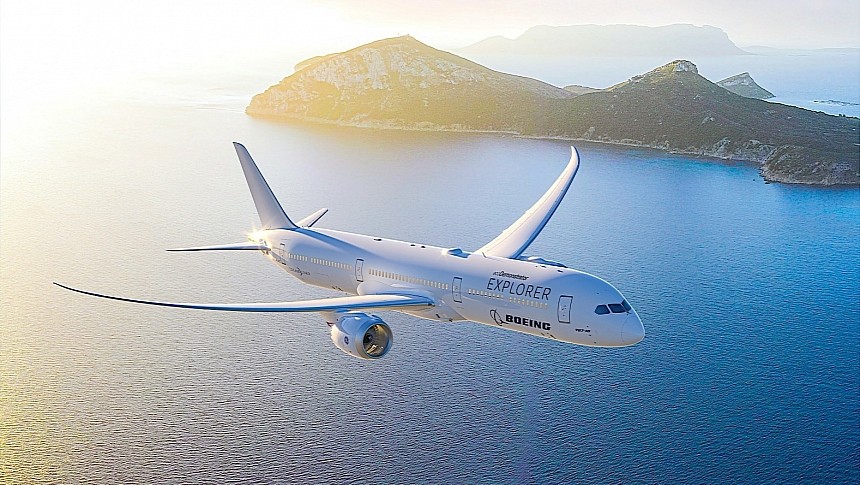Those streaks of cloud you often see in the sky trailing behind airplanes are called contrails. Unlike what some would tell you, they are not the result of some maleficent force dispersing harmful substances in the air, but a very normal natural phenomenon.
Contrails are born when an airplane's engine fuel combustion results in water vapor. Because usually planes fly very high, where it's very cold, that vapor rapidly condenses, taking advantage of the presence of substances such as sulfur aerosols. What you see, thus, are more or less ice crystals, lingering in the air for long after airplanes have moved on.
Because airplanes mostly use the same kind of fuel, the same kind of effects happen when the conditions are right. As it stands, though, the industry is moving toward employing alternative fuels on a larger scale, such as sustainable aviation fuel (SAF). And there is very little data on how that affects contrails.
That could change thanks to a cooperative effort made by Boeing, NASA, and United Airlines. The three organizations have joined forces to get a better understanding of how SAF affects contrails, but also what kind of non-carbon emissions are released from the stuff burning inside the engines.
It's quite an impressive effort, as it will see a Boeing-made airplane flown by United Airlines, a NASA chase plane, and even satellites.
How is this going to go? A Boeing 737-10, meant for United Airlines and called ecoDemonstrator Explorer, will be filled with both SAF and conventional fuel, in separate tanks. The plane will burn each fuel alternatively during the test flight.
Behind the Explorer will fly a NASA DC-8 called the Airborne Science Lab. Using the onboard hardware, it will take a close look at both the emissions produced when each type of fuel is burned, but also at the contrail ice particles.
From space, an undisclosed number of satellites will follow the flight, snapping pictures of contrail formation.
The main goal of the exercise is to "understand how advanced fuels, engine combustor designs and other technologies may reduce atmospheric warming." But what do contrails have to do with atmospheric warming?
As per Boeing, there are hints that contrails may not be as harmless as initially believed after all. They are not poisonous to living creatures, as some seem to think, but they may trap heat in the atmosphere, contributing to warming effects.
Getting a better idea of how SAF affects the atmosphere is essential because more and more airplanes are adopting it. That's because when compared to regular fuel, the substance is made of sustainably produced feedstocks, emits as much as 85 percent fewer harmful substances, and produces far less soot.
The effort seems to be a massive one, as it only only includes the three parties mentioned above, but also others. The test is funded by the U.S. Federal Aviation Administration (FAA) and GE Aerospace (which also offers technical expertise), while the many instruments that will be used during the procedures are supplied by the German Aerospace Center (DLR).
There is no mention as to when the tests will be conducted, and how long it will take until the results are in.
Because airplanes mostly use the same kind of fuel, the same kind of effects happen when the conditions are right. As it stands, though, the industry is moving toward employing alternative fuels on a larger scale, such as sustainable aviation fuel (SAF). And there is very little data on how that affects contrails.
That could change thanks to a cooperative effort made by Boeing, NASA, and United Airlines. The three organizations have joined forces to get a better understanding of how SAF affects contrails, but also what kind of non-carbon emissions are released from the stuff burning inside the engines.
It's quite an impressive effort, as it will see a Boeing-made airplane flown by United Airlines, a NASA chase plane, and even satellites.
How is this going to go? A Boeing 737-10, meant for United Airlines and called ecoDemonstrator Explorer, will be filled with both SAF and conventional fuel, in separate tanks. The plane will burn each fuel alternatively during the test flight.
Behind the Explorer will fly a NASA DC-8 called the Airborne Science Lab. Using the onboard hardware, it will take a close look at both the emissions produced when each type of fuel is burned, but also at the contrail ice particles.
From space, an undisclosed number of satellites will follow the flight, snapping pictures of contrail formation.
The main goal of the exercise is to "understand how advanced fuels, engine combustor designs and other technologies may reduce atmospheric warming." But what do contrails have to do with atmospheric warming?
As per Boeing, there are hints that contrails may not be as harmless as initially believed after all. They are not poisonous to living creatures, as some seem to think, but they may trap heat in the atmosphere, contributing to warming effects.
Getting a better idea of how SAF affects the atmosphere is essential because more and more airplanes are adopting it. That's because when compared to regular fuel, the substance is made of sustainably produced feedstocks, emits as much as 85 percent fewer harmful substances, and produces far less soot.
The effort seems to be a massive one, as it only only includes the three parties mentioned above, but also others. The test is funded by the U.S. Federal Aviation Administration (FAA) and GE Aerospace (which also offers technical expertise), while the many instruments that will be used during the procedures are supplied by the German Aerospace Center (DLR).
There is no mention as to when the tests will be conducted, and how long it will take until the results are in.









